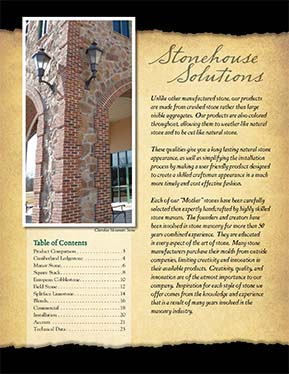Installation
Calculating Materials
Stone Flats – Length x width = sq . ft . necessary
Stone Corners – Vertically measure each corner, and remember to back out from flats quantity .
Mortar – Non-Grouted Projects equal approximately 3 bags per 100 sq . ft . Grouted Projects equal approximately 4 bags per 100 sq . ft . (Quantities include scratch coat)
Sand – 150 lbs . of sand per bag of mortar
Felt Paper – In most cases 400 sq . ft . per roll
Metal Lathe – Pieces are approximately 18 sq . ft . should be calculated at 16 ft . per sq . ft . to allow for overlap NOTE: It is recommended to sponge off walls and back of stone to remove any dust or debris before applying stone .
Water Management
Stone and mortar of any kind are not waterproofing systems. Felt paper must be used on all exterior mortar applications with the exception of untreated block, brick, masonry stucco, concrete or other untreated, unpainted masonry products . Follow all requirements according to building code standards prior to installation. This includes but is not limited to: Flashing, weather resistant wrap, and Flashing tape around windows and doors .2 layers of Felt paper should be installed from the bottom up overlapping at least 4 inches on each new course.
Mortar Preparation
Standard Type S Mortar is used in applying stone . The following are recommended mixing instructions based upon 1- 84lb . bag of masonry:
1 84lb . Bag of Type S Masonry 150 lbs . of sand Approximately 3-4 Gallons of water Mix to desired consistency
(Some sand may be more wet or dry depending on
sand provider . Adjust water to compensate .)
Scratch coat usually is thicker (less water), Setting mortar, thinner (more water)
Metal Lathe
Install metal lathe to studs using galvanized nails or staples every 6-12 inches on center with a minimum of 1” penetration . Overlap lathe sides a minimum of 2” maximum 3” .
Scratch Coat
Apply a 1/2” scratch coat of mortar covering every cell of lathe . Strike lines in the scratch coat with a notched trowel or coarse brush for added mortar lock bond . Allow time to cure .
Grout/Joint Finish
A grout bag is used to fill the voids between stones . All grout joints must be pressed and tooled with tug pointing tools . For a standard grout application apply between stones, allow grout to become firm, then use a tug point tool to rake the excess grout to the depth desired . Stonehouse Solutions recommend a grout joint on all applications . Based on the desired look, you may use anything from a wider joint down to a deeply tugged minimal joint for drystack applications
Necessary Tools
Wheel Barrow
Mason’s Hammer
Staple Gun and Fasteners
Margin Trowel
Brick or Pointed Trowel
Notched Trowel
Flat Trowel
Wide Mouth Nippers
Tug Pointing Tool
Grout Bag
Wire Brush
Acid Brush or Soft Brush
Mason’s Hoe
Sponge and Bucket of Water
 Download PDF Brochure
Download PDF Brochure